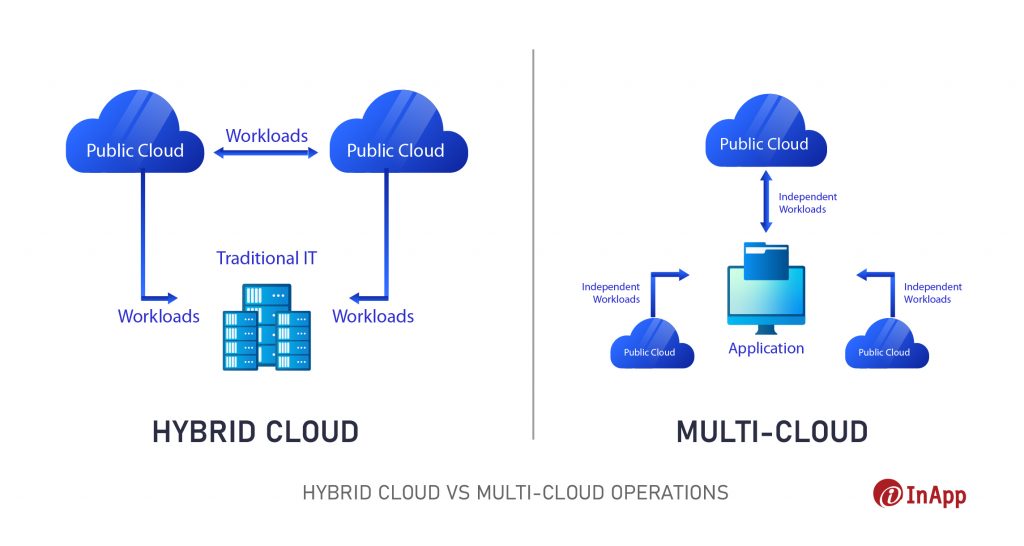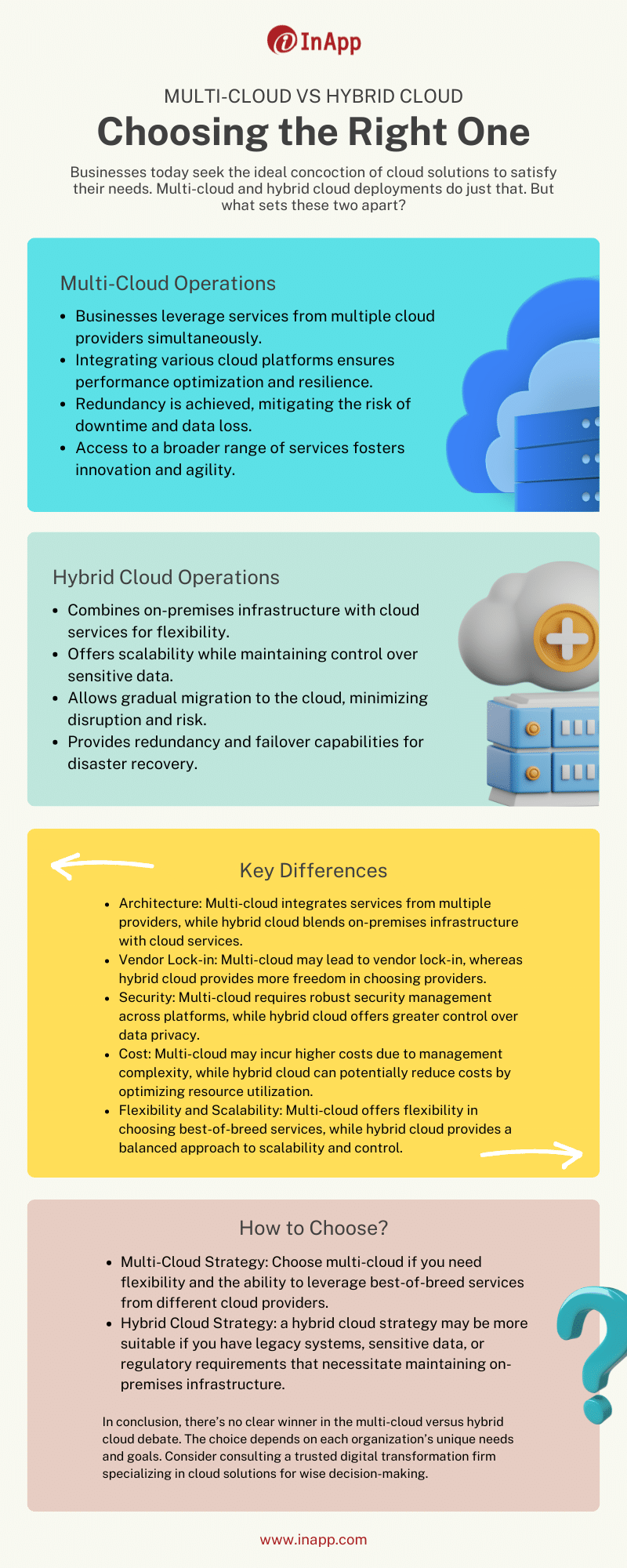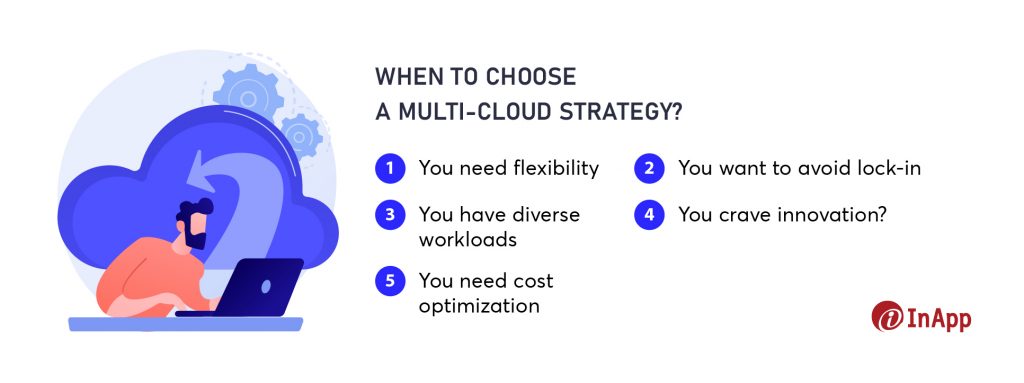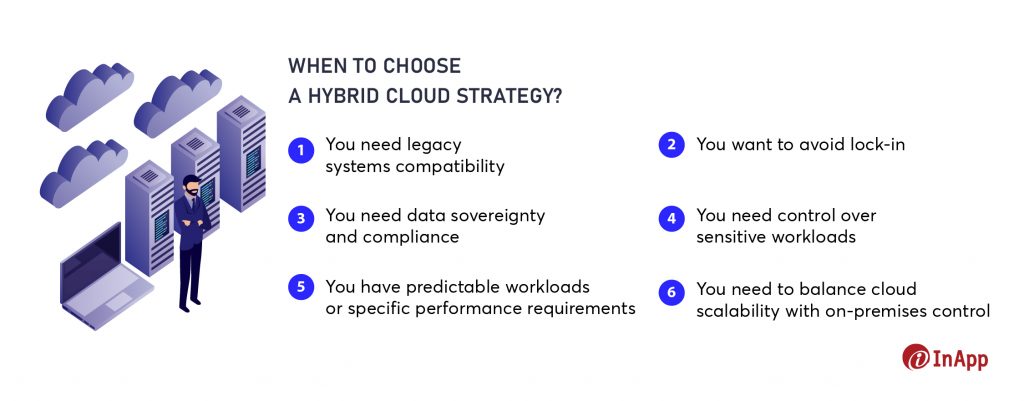Businesses today seek the ideal concoction of cloud solutions to satisfy their needs. Multi-cloud and hybrid cloud deployments do just that.
But what sets these two apart?
Hybrid cloud integrates on-premises infrastructure with cloud services whereas, multi-cloud utilizes services from multiple cloud providers. While hybrid focuses on blending, multi-cloud emphasizes leveraging diverse provider offerings simultaneously for various business needs.
For an easier understanding, consider hybrid cloud as the fusion of apples and oranges, while multi-cloud mixes various types of apples. To understand this better and to gain clarity on choosing the right solution for your business, let’s take a deep dive into the nuances of cloud computing and explore how these approaches can aid your business operations.
What Are Multi and Hybrid Cloud Systems?
Multi-cloud and hybrid cloud are cloud deployment models that integrate more than one cloud.
Multi-cloud involves utilizing services from multiple cloud providers. It’s akin to having a diverse toolbox, leveraging the strengths of different providers for various tasks. Hybrid cloud, on the other hand, blends on-premises infrastructure with cloud services, offering scalability and security. It’s like having a seamless fusion of in-house and off-site resources, ensuring optimal performance and control.
Both approaches cater to diverse business needs, allowing organizations to adapt to changing demands efficiently. Whether it’s leveraging the versatility of multiple providers or achieving a balanced mix of on-premises and cloud resources, multi and hybrid cloud systems help businesses to thrive in the digital age.


Multi-Cloud Operations
As discussed, Multi-Cloud operations are where businesses leverage services from multiple cloud providers simultaneously. This allows organizations to diversify their infrastructure, optimizing performance, resilience, and cost-effectiveness.
The core feature of Multi-Cloud Operations is its ability to integrate various cloud platforms, whether public, private, or hybrid, into a cohesive ecosystem. This integration facilitates workload portability, enabling applications to run on the most suitable cloud environment based on specific requirements such as latency, compliance, or cost.
One key advantage of Multi-Cloud Operations is redundancy. By distributing workloads across multiple cloud providers, organizations mitigate the risk of downtime and data loss associated with relying on a single vendor. Additionally, it fosters vendor independence, giving businesses the freedom to choose services based on performance, pricing, and feature sets without being locked into one provider.
Moreover, Multi-Cloud Operations promote innovation and agility. Organizations can tap into a broader range of services and capabilities offered by different cloud providers, fostering experimentation and accelerating time-to-market for new products and services.
Some scenarios where a company might opt for a multi-cloud model are,
- Geographical Expansion: Businesses expanding their operations globally may opt for a multi-cloud deployment to ensure optimal performance and compliance with local regulations. By using different cloud providers with data centers in various regions, they can minimize latency and adhere to data sovereignty laws.
- Risk Mitigation: To mitigate the risk of service outages or data breaches, companies may employ a multi-cloud strategy. By distributing workloads across multiple cloud platforms, businesses can reduce the impact of potential disruptions from a single provider.
- Cost Optimization: Multi-cloud deployments allow companies to leverage competitive pricing and take advantage of discounts offered by different providers.
- Specialized Services: Companies with diverse IT needs may utilize a multi-cloud approach to access specialized services offered by different providers. For example, they may leverage Google Cloud‘s advanced analytics tools, AWS’s machine learning capabilities, and Microsoft Azure’s IoT services, tailoring their infrastructure to specific requirements.
- Vendor Lock-in Avoidance: Concerns about vendor lock-in can drive companies to adopt a multi-cloud strategy. By spreading their infrastructure across multiple providers, organizations retain flexibility and bargaining power, avoiding dependence on any single vendor.
Hybrid Cloud Operations
Hybrid cloud Operations combine on-premises infrastructure with cloud services, offering a flexible and versatile approach to IT management. This model allows organizations to retain certain workloads and data on their servers while leveraging the scalability and accessibility of cloud resources.
Hybrid cloud operations involve blending on-site infrastructure with public or private cloud setups. This mix lets businesses easily manage workloads based on performance needs, data sensitivity, and meeting regulations.
One significant advantage of Hybrid cloud Operations is flexibility. Companies can scale their resources up or down as needed, utilizing on-premises infrastructure for stable workloads and cloud services for peak demand periods, ensuring optimal performance and cost-effectiveness.
Furthermore, Hybrid cloud Operations provide a pathway for digital transformation. Businesses can modernize their IT infrastructure by gradually migrating workloads to the cloud while maintaining legacy systems on-premises, minimizing disruption and risk.
Some scenarios where a company might opt for a hybrid cloud model are,
1. Data Compliance Requirements: Companies operating in highly regulated industries, such as finance or healthcare, need to adhere to strict data compliance regulations. A hybrid cloud deployment allows them to store sensitive data on-premises while leveraging the scalability and flexibility of the cloud for less sensitive workloads.
2. Seasonal Workloads: Businesses with fluctuating demands throughout the year, such as retail during holiday seasons or tax firms during tax season, can benefit from a hybrid cloud model. They can utilize on-premises infrastructure for baseline workloads and seamlessly scale up to the cloud during peak periods without overspending on resources.
3. Legacy System Integration: Companies with existing legacy systems may face challenges in migrating all their applications and data to the cloud due to compatibility issues or cost constraints. A hybrid cloud approach allows them to gradually transition to the cloud, ensuring continuity of operations while modernizing their infrastructure.
5. Geographic Reach: Businesses with a global presence may opt for a hybrid cloud deployment to ensure low-latency access to their applications and data across different regions. By deploying on-premises infrastructure in strategic locations and leveraging cloud services for scalability and redundancy, they can provide a seamless user experience to customers and employees worldwide.
6. Disaster Recovery and Business Continuity: A hybrid cloud deployment enables organizations to replicate mission-critical data and applications between on-premises and cloud environments, providing redundancy and failover capabilities. In the event of a disaster or system outage, they can quickly recover operations by failover to the cloud infrastructure while maintaining data integrity and minimizing downtime.
Hybrid Cloud vs Multi-Cloud: What Are the Key Differences?
Now that we’ve explored the concepts of multi-cloud and hybrid cloud, let us dig deep into their distinctions. We’ll dissect their differences across key factors such as architecture, vendor lock-in, security, cost, and flexibility. This comparative analysis will help you make informed decisions about cloud deployments.
| Multi-Cloud | Hybrid cloud | |
| Architecture | Involves using services from multiple cloud providers simultaneously. It entails deploying workloads across different cloud platforms, which may require additional management overhead for integration and orchestration. | Combines on-premises infrastructure with public or private cloud services, creating a unified environment. It allows for seamless integration between on-premises resources and cloud resources, enabling workload portability and flexibility. |
| Vendor Lock-in | May lead to vendor lock-in if not managed properly. Each cloud provider has its ecosystem of services and APIs, making it challenging to migrate workloads between providers without significant effort and potential data transformation. | Provides more freedom and flexibility in choosing cloud providers, reducing the risk of vendor lock-in. |
| Security | Causes complexity in security management, as organizations need to implement consistent security policies across multiple cloud platforms. It requires robust identity and access management, encryption, and monitoring solutions to ensure data security. | Offers greater control and visibility over data and security policies, especially for sensitive workloads. Organizations can keep critical data on-premises while leveraging cloud services for less sensitive tasks, enhancing data privacy and compliance. |
| Cost | May lead to higher costs due to the complexity of managing multiple cloud providers and potential data transfer fees between providers. | Can potentially reduce costs by optimizing resource utilization and leveraging existing on-premises infrastructure investments. |
| Flexibility and Scalability | Provides greater flexibility in choosing best-of-breed services from different cloud providers for specific use cases. It enables organizations to leverage specialized services and features offered by each provider, enhancing innovation and agility. | Offers a balanced approach to flexibility and scalability by combining the scalability of cloud services with the control of on-premises infrastructure. It allows organizations to scale resources horizontally and vertically based on workload demands. |
How To Choose the Right Cloud Option for Your Business?
Choosing between a multi-cloud strategy and a hybrid cloud strategy depends on various factors, including your business needs, workload requirements, and architectural preferences.
When to choose a Multi-Cloud Strategy?
You should opt for a multi-cloud strategy if you require flexibility, and the ability to leverage best-of-breed services from different cloud providers. Multi-cloud allows you to avoid vendor lock-in, mitigate risks associated with relying on a single provider, and optimize costs by selecting the most cost-effective services for each workload.
Moreover, if your applications have diverse requirements, such as specific geographic locations, compliance needs, or performance demands, a multi-cloud approach can provide the necessary agility and customization. By leveraging services from multiple providers, you can distribute workloads strategically, optimizing performance and minimizing latency.
Additionally, if innovation and experimentation are priorities for your organization, a multi-cloud strategy enables you to access a broader range of services, features, and capabilities offered by different cloud providers.

When to choose a Hybrid cloud Strategy?
On the other hand, a hybrid cloud strategy may be more suitable if you have legacy systems, sensitive data, or regulatory requirements that necessitate maintaining on-premises infrastructure. A hybrid cloud allows you to combine the scalability and agility of cloud services with the control and security of on-premises resources.
If your organization requires data sovereignty, compliance with industry regulations, or strict control over sensitive workloads, a hybrid cloud approach provides the necessary balance between the benefits of cloud computing and the security of on-premises infrastructure.
Furthermore, if you have predictable workloads or specific performance requirements better suited to on-premises infrastructure, a hybrid cloud strategy enables you to maintain control over critical workloads while leveraging cloud services for scalability and flexibility.

In short, the decision of choosing between a multi-cloud strategy and a hybrid cloud strategy needs to be made considering the workload requirements, and architectural preferences to determine which approach aligns best with your objectives and priorities.
Simply put, there’s no clear winner in the multi-cloud versus hybrid cloud debate. The choice hinges on each organization’s unique needs, goals, and limitations. Both methods come with their pros and cons, and there’s no universal answer. To decide wisely, consider consulting a trusted digital transformation firm specializing in cloud solutions.
